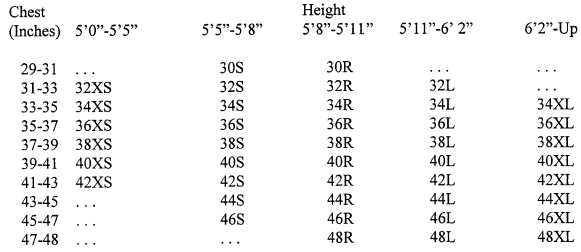TM 10--227
3--7
(5) All Weather Coat.
(a) SubGarments. The subgarments for the chest measurement are the undershirt and
dress shirt. Subgarments for the all weather coat try--on are the undershirt, shirt, trousers and
coat.
(b) Measurements. The chest and height measurement are needed to select try--on size
and model.
(c) Selection of Try–On Garment. Attach all weather coat line for try--on purposes. Using
the individual’s height and chest measurements, refer to size prediction table 3--6 for size of the
initial try--on garment. If the individual’s measurements are close to the minimum or maximum
indicated on the size prediction table, select two sizes for try--on. For example, if the individual’s
height is 5 feet, 11 inches, and his chest measurement is between 43 and 45 inches, try--on both
the 44 regular and 44 long to get the proper length garment. If the individual’s height is 5 feet, 10
inches with a chest measurement of 43 inches, try--on both the 42 regular and 44 regular. In
either case, if the selected garment does not fit, try--on additional garments until the best fit is
achieved prior to making alterations.
Table 3-6 Size Prediction Table For The All Weather Coat For Male Personnel.
(d) Alterations.The only alterations authorized are the shortening of the sleeves and
adjustment of the raincoat length. When shortening the sleeves, measure and mark each sleeve
individually.
e. Final Check for Proper Concept of Fit. While the individual is wearing the entire uniform
(Figs. 3--1 and 3--2), check the following points:
(1) Shirt (Short or Long Sleeve). Completely button shirt, including the cuffs of the long
sleeve shirt, and check the following points:
(a) Chest and Shoulders. There must be enough room around the chest and shoulders to
allow free use of the arms without discomfort.
(b) Collar. The collar should fit snugly enough to give a neat appearance, but not snug as
to be uncomfortable.
(c) Sleeves. The sleeves of the long sleeve shirt must fall to the lower part of the
wristbone.

